ESP32 based Biometric Door Lock system using R307 Fingerprint Sensor & Blynk IoT
IoT based Fingerprint Door Lock System with ESP32
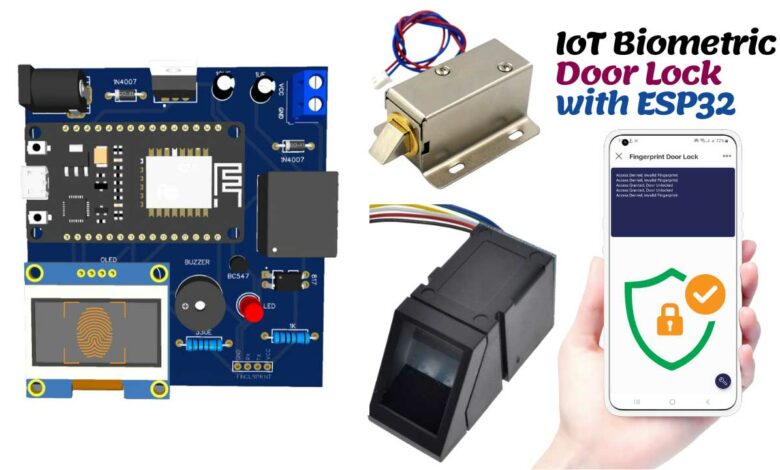
Today we are building an ESP32-based biometric door lock system using the R307 fingerprint sensor and Blynk IoT platform. In this tutorial, we’ll guide you through the entire process of setting up the hardware, programming the ESP32, and configuring the Blynk web dashboard. So, Let’s get started!
Overview: ESP32 based IoT Fingerprint Door Lock
First, let’s understand how this system works. The ESP32, along with the R307 fingerprint sensor, acts as the main controller for the door lock system. The system allows authorized users to unlock the door using their fingerprints. Once a fingerprint is scanned, the ESP32 verifies it with the stored fingerprints in its memory. If the fingerprint matches, the ESP32 triggers the solenoid door lock, granting access to the user.
A small 0.96-inch OLED Display displays information like Access Denied or Access Granted through graphics.
You can also monitor your door lock remotely from anywhere in the world using Blynk IoT mobile App as well as the blynk web dashboard.
- Fingerprint Door Lock Security Systems Using Arduino & LCD
- Fingerprint Door Lock System using Arduino and Smartphone
- IoT Smart RFID Door Lock System Using NodeMCU ESP8266
- ESP32 Smart Home Automation using DWIN HMI Display
Hardware Requirements
To build this ESP32 based Biometric Door Lock system using R307 Fingerprint Sensor. You’ll need the following hardware components:
| S.N | COMPONENTS NAME | QUANTITY | PURCHASE LINKS |
|---|---|---|---|
| 1 | ESP32 Dev Kit V1 Board | 1 | Amazon | AliExpress |
| 2 | R307 Fingerprint Sensor | 1 | Amazon | AliExpress |
| 3 | 0.96 inch OLED Display | 1 | Amazon | AliExpress |
| 4 | 12V Solenoid Lock | 1 | Amazon | AliExpress |
| 5 | Single channel 5V Relay Module | 1 | Amazon | AliExpress |
| 6 | Breadboard | 1 | Amazon | AliExpress |
| 7 | Buzzer | 1 | Amazon | AliExpress |
| 8 | Jumper Cables | 20 | Amazon | AliExpress |
Hardware Connection
Now, let’s connect all the components. The connections are fairly straightforward and will be as follows:
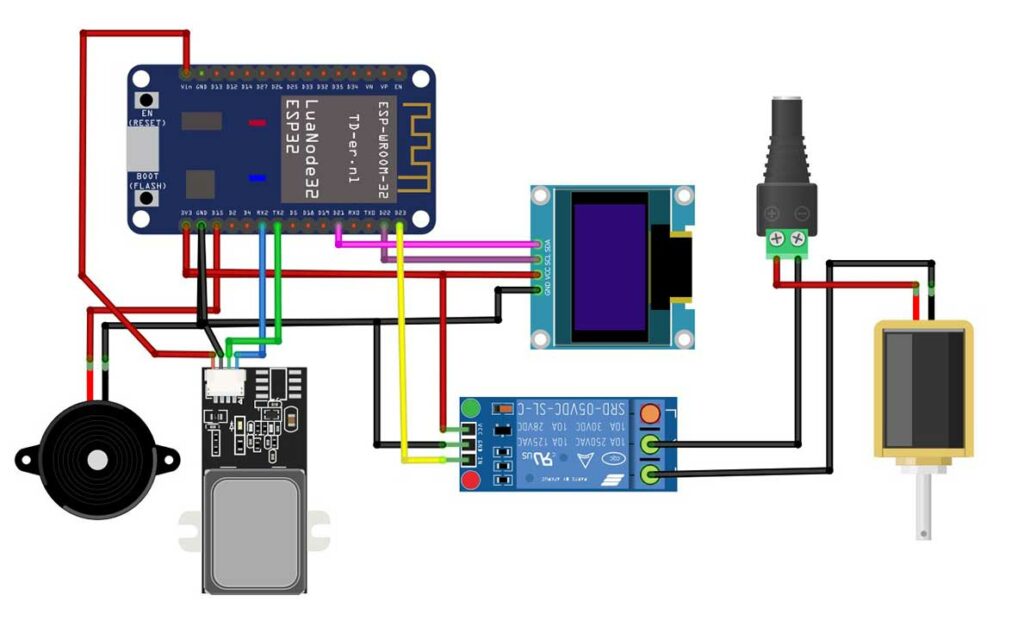
- VCC pin of the fingerprint sensor to the Vin pin on the ESP32
- GND pin of the fingerprint sensor to the GND pin on the ESP32
- TX pin of the fingerprint sensor to RX2 pin on the ESP32
- RX pin of the fingerprint sensor to TX2 pin on the ESP32
- Relay Pin to ESP32 pin D23
- OLED SDA pin to ESP32 Pin D21
- OLED SCL pin to ESP32 Pin D22
- OLED VCC pin to ESP32 3.3V
- OLED GND pin to ESP32 GND
Project PCB Gerber File & PCB Ordering Online
If you don’t want to assemble the circuit on a zero PCB and you want PCB for the project, then here is the PCB for you. The PCB Board for this project looks something like below.
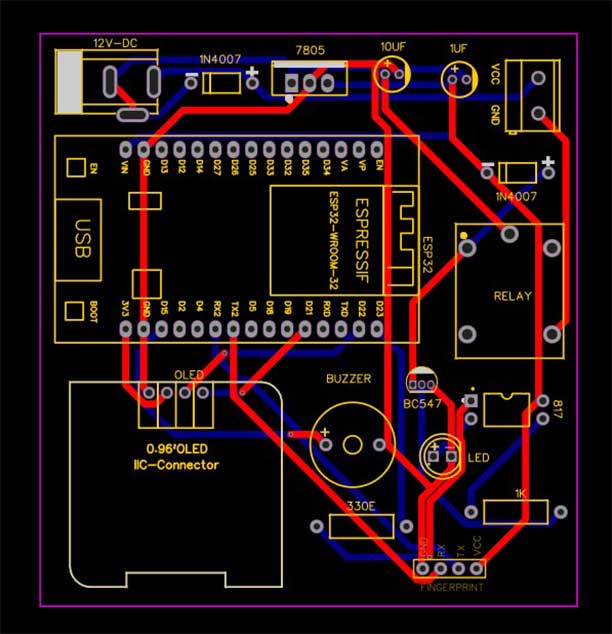
The Gerber File for the PCB is given below. You can simply download the Gerber File and order the PCB from PCBWay.com.
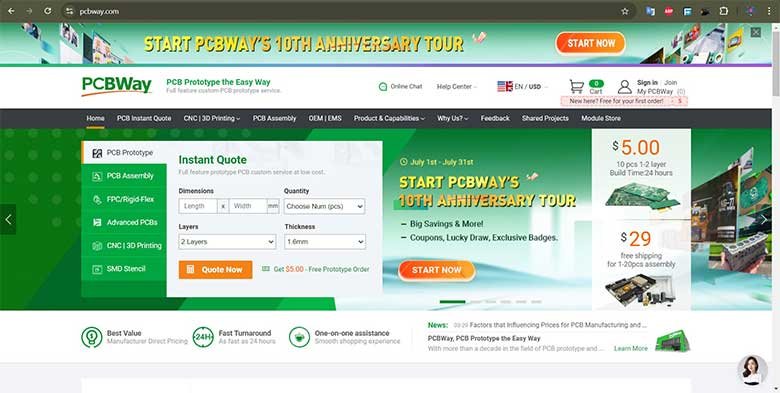
PCBWay has been a trusted partner for PCB prototyping, manufacturing, and assembly for a decade now. To celebrate this milestone, they have a bunch of exciting deals and giveaways lined up. You can visit their special anniversary page at www.pcbway.com/activity/anniversary10th.html to participate.
I’ve been using PCBWay for my own projects, and their quality and customer service have always been top-notch. Whether you’re a hobbyist or a professional, PCBWay’s services are perfect for bringing your ideas to life.
And during this anniversary celebration, they are offering discounts, free trials, and even a chance to win some fantastic prizes!
So, what are you waiting for? Head over to PCBWay.com and join in the celebration. Let’s make some great projects together. Thanks again to PCBWay for sponsoring this project.
You can now upload the Gerber File to the Website and place an order. The PCB quality is superb & high standard. That is why most people trust PCBWay for PCB & PCBA Services. PCBWay is a leading manufacturer of high-quality PCBs and offers a wide range of services, including PCB fabrication, assembly, and components sourcing.
Setting up Blynk Web Dashboard
Next, let’s configure the Blynk web dashboard for our system. Start by creating a new template in the Blynk app.
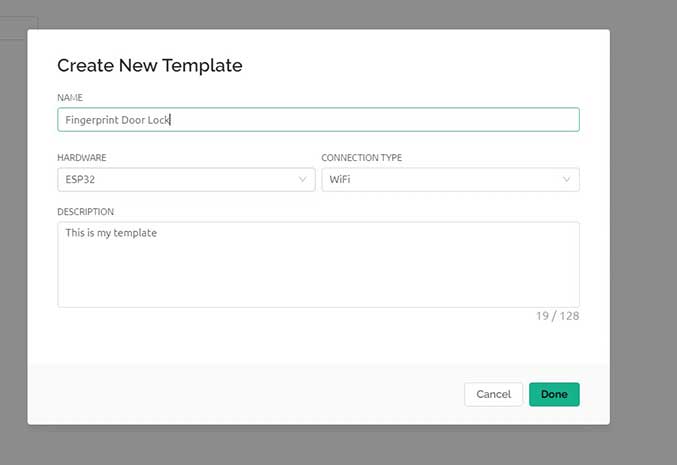
On a web Dashboard, add a Terminal widget and customize its properties. Create a Datastream connected to Virtual Pin V0. Choose its data type as a string.
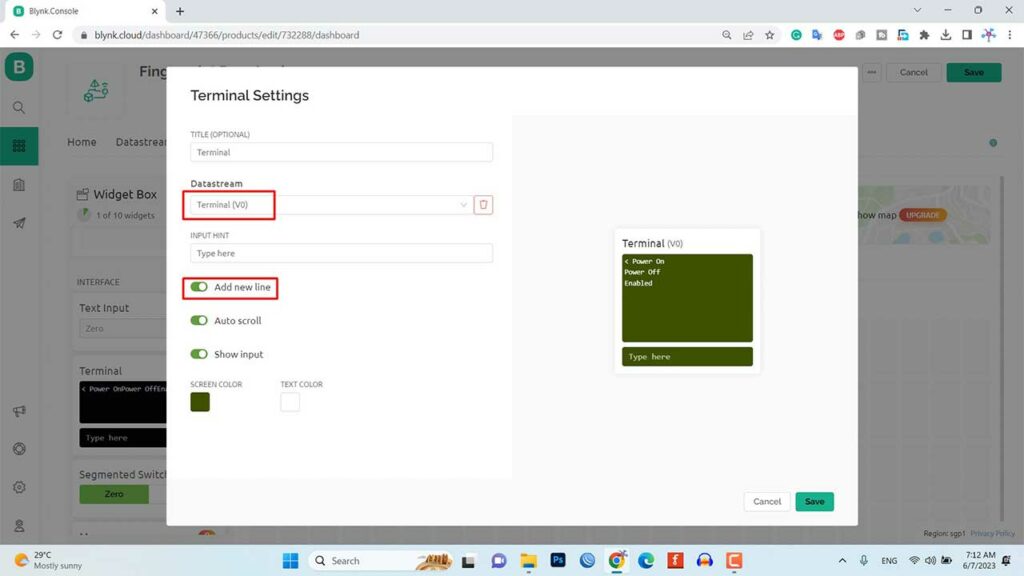
Once you’re done, add the device to the Blynk app using the template. Make sure to copy the Blynk authentication token for later use.
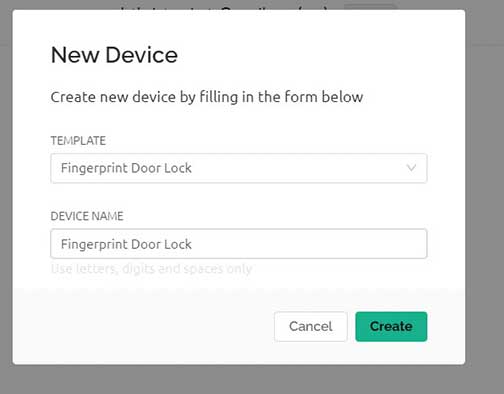
Program Code
Now, let’s take a look at the program code. Open the Arduino IDE or your preferred IDE, and paste the program code provided below.
#include <Adafruit_Fingerprint.h> //https://github.com/adafruit/Adafruit-Fingerprint-Sensor-Library
#include <HardwareSerial.h>
#include <Adafruit_GFX.h> //https://github.com/adafruit/Adafruit-GFX-Library
#include <Adafruit_SSD1306.h> //https://github.com/adafruit/Adafruit_SSD1306
#include <SPI.h>
#include <Wire.h>
#define BLYNK_PRINT Serial
#include <WiFi.h>
#include <WiFiClient.h>
#include <BlynkSimpleEsp32.h>
/* Fill-in your Template ID (only if using Blynk.Cloud) */
#define BLYNK_TEMPLATE_ID "TMPL6alI-f6lt"
#define BLYNK_TEMPLATE_NAME "Fingerprint Door Lock"
#define BLYNK_AUTH_TOKEN "W1ZqMfrYEiUwaca_ERfx_2DkF3XuzifEi"
// Your WiFi credentials.
// Set password to "" for open networks.
char ssid[] = "IoT Projects Ideas";
char pass[] = "@12345678";
char auth[] = BLYNK_AUTH_TOKEN;
SimpleTimer timer;
#define SCREEN_WIDTH 128 // OLED display width, in pixels
#define SCREEN_HEIGHT 64 // OLED display height, in pixels
// Declaration for an SSD1306 display connected to I2C (SDA, SCL pins)
#define OLED_RESET -1 // Reset pin # (or -1 if sharing Arduino reset pin)
Adafruit_SSD1306 display(SCREEN_WIDTH, SCREEN_HEIGHT, &Wire, OLED_RESET);
WidgetTerminal terminal(V0);
// Icon of Fingerprint
#define LOGO_HEIGHT 64
#define LOGO_WIDTH 128
static const unsigned char PROGMEM logo_bmp[] =
{
0x00, 0x00, 0x00, 0x00, 0x00, 0x00, 0x00, 0x00, 0x00, 0x00, 0x00, 0x00, 0x00, 0x00, 0x00, 0x00,
0x00, 0x00, 0x00, 0x00, 0x00, 0x00, 0x00, 0x00, 0x00, 0x00, 0x00, 0x00, 0x00, 0x00, 0x00, 0x00,
0x00, 0x00, 0x00, 0x00, 0x00, 0x00, 0x03, 0xff, 0xc0, 0x00, 0x00, 0x00, 0x00, 0x00, 0x00, 0x00,
0x00, 0x00, 0x00, 0x00, 0x00, 0x00, 0x3f, 0xff, 0xfc, 0x00, 0x00, 0x00, 0x00, 0x00, 0x00, 0x00,
0x00, 0x00, 0x00, 0x00, 0x00, 0x00, 0xff, 0xff, 0xff, 0x00, 0x00, 0x00, 0x00, 0x00, 0x00, 0x00,
0x00, 0x00, 0x00, 0x00, 0x00, 0x03, 0xff, 0x83, 0xff, 0xc0, 0x00, 0x00, 0x00, 0x00, 0x00, 0x00,
0x00, 0x00, 0x00, 0x00, 0x00, 0x0f, 0xf0, 0x00, 0x0f, 0xf0, 0x00, 0x00, 0x00, 0x00, 0x00, 0x00,
0x00, 0x00, 0x00, 0x00, 0x00, 0x1f, 0x80, 0x00, 0x03, 0xf8, 0x00, 0x00, 0x00, 0x00, 0x00, 0x00,
0x00, 0x00, 0x00, 0x00, 0x00, 0x7e, 0x03, 0xff, 0xc0, 0xfe, 0x00, 0x00, 0x00, 0x00, 0x00, 0x00,
0x00, 0x00, 0x00, 0x00, 0x00, 0xfc, 0x3f, 0xff, 0xf8, 0x3f, 0x00, 0x00, 0x00, 0x00, 0x00, 0x00,
0x00, 0x00, 0x00, 0x00, 0x01, 0xf0, 0xff, 0xff, 0xfe, 0x0f, 0x00, 0x00, 0x00, 0x00, 0x00, 0x00,
0x00, 0x00, 0x00, 0x00, 0x01, 0xe1, 0xff, 0x00, 0xff, 0x87, 0x00, 0x00, 0x00, 0x00, 0x00, 0x00,
0x00, 0x00, 0x00, 0x00, 0x01, 0xc7, 0xf0, 0x00, 0x1f, 0xe0, 0x00, 0x00, 0x00, 0x00, 0x00, 0x00,
0x00, 0x00, 0x00, 0x00, 0x01, 0x8f, 0xc0, 0x00, 0x03, 0xf0, 0x00, 0x00, 0x00, 0x00, 0x00, 0x00,
0x00, 0x00, 0x00, 0x00, 0x00, 0x1f, 0x03, 0xff, 0xc1, 0xf8, 0x00, 0x00, 0x00, 0x00, 0x00, 0x00,
0x00, 0x00, 0x00, 0x00, 0x00, 0x3e, 0x0f, 0xff, 0xf0, 0x7c, 0x00, 0x00, 0x00, 0x00, 0x00, 0x00,
0x00, 0x00, 0x00, 0x00, 0x00, 0x7c, 0x3f, 0xff, 0xfc, 0x3e, 0x00, 0x00, 0x00, 0x00, 0x00, 0x00,
0x00, 0x00, 0x00, 0x00, 0x00, 0xf8, 0xff, 0x00, 0xff, 0x1f, 0x00, 0x00, 0x00, 0x00, 0x00, 0x00,
0x00, 0x00, 0x00, 0x00, 0x00, 0xf1, 0xf8, 0x00, 0x1f, 0x8f, 0x80, 0x00, 0x00, 0x00, 0x00, 0x00,
0x00, 0x00, 0x00, 0x00, 0x01, 0xe3, 0xf0, 0x18, 0x0f, 0xc7, 0xc0, 0x00, 0x00, 0x00, 0x00, 0x00,
0x00, 0x00, 0x00, 0x00, 0x03, 0xc7, 0xc1, 0xff, 0x83, 0xe3, 0xc0, 0x00, 0x00, 0x00, 0x00, 0x00,
0x00, 0x00, 0x00, 0x00, 0x03, 0xc7, 0x87, 0xff, 0xe1, 0xf1, 0xc0, 0x00, 0x00, 0x00, 0x00, 0x00,
0x00, 0x00, 0x00, 0x00, 0x07, 0x8f, 0x1f, 0xff, 0xf0, 0xf0, 0x00, 0x00, 0x00, 0x00, 0x00, 0x00,
0x00, 0x00, 0x00, 0x00, 0x07, 0x1e, 0x3f, 0x01, 0xf8, 0x78, 0x00, 0x00, 0x00, 0x00, 0x00, 0x00,
0x00, 0x00, 0x00, 0x00, 0x07, 0x1e, 0x7e, 0x00, 0x7c, 0x79, 0xc0, 0x00, 0x00, 0x00, 0x00, 0x00,
0x00, 0x00, 0x00, 0x00, 0x00, 0x3c, 0x78, 0x00, 0x3e, 0x3d, 0xc0, 0x00, 0x00, 0x00, 0x00, 0x00,
0x00, 0x00, 0x00, 0x00, 0x00, 0x78, 0xf0, 0xff, 0x1f, 0x3d, 0xe0, 0x00, 0x00, 0x00, 0x00, 0x00,
0x00, 0x00, 0x00, 0x00, 0x00, 0x79, 0xe1, 0xff, 0x8f, 0x1c, 0xe0, 0x00, 0x00, 0x00, 0x00, 0x00,
0x00, 0x00, 0x00, 0x00, 0x00, 0xf1, 0xe3, 0xff, 0xc7, 0x1e, 0xe0, 0x00, 0x00, 0x00, 0x00, 0x00,
0x00, 0x00, 0x00, 0x00, 0x01, 0xe3, 0xc7, 0xc3, 0xc7, 0x9e, 0xf0, 0x00, 0x00, 0x00, 0x00, 0x00,
0x00, 0x00, 0x00, 0x00, 0x07, 0xe3, 0x8f, 0x01, 0xe7, 0x9e, 0xf0, 0x00, 0x00, 0x00, 0x00, 0x00,
0x00, 0x00, 0x00, 0x00, 0x0f, 0xc7, 0x8f, 0x00, 0xe3, 0x9e, 0xf0, 0x00, 0x00, 0x00, 0x00, 0x00,
0x00, 0x00, 0x00, 0x00, 0x0f, 0x8f, 0x9e, 0x18, 0xf3, 0x9e, 0x70, 0x00, 0x00, 0x00, 0x00, 0x00,
0x00, 0x00, 0x00, 0x00, 0x0e, 0x0f, 0x1e, 0x38, 0xf3, 0x9e, 0x70, 0x00, 0x00, 0x00, 0x00, 0x00,
0x00, 0x00, 0x00, 0x00, 0x00, 0x1e, 0x3c, 0x38, 0xf3, 0x9e, 0x70, 0x00, 0x00, 0x00, 0x00, 0x00,
0x00, 0x00, 0x00, 0x00, 0x00, 0x3c, 0x3c, 0x78, 0xf7, 0x9c, 0x70, 0x00, 0x00, 0x00, 0x00, 0x00,
0x00, 0x00, 0x00, 0x00, 0x00, 0x7c, 0x78, 0x78, 0xe7, 0x9c, 0x70, 0x00, 0x00, 0x00, 0x00, 0x00,
0x00, 0x00, 0x00, 0x00, 0x01, 0xf0, 0xf0, 0xf1, 0xe7, 0x9c, 0x70, 0x00, 0x00, 0x00, 0x00, 0x00,
0x00, 0x00, 0x00, 0x00, 0x03, 0xe1, 0xf1, 0xe1, 0xe7, 0x3c, 0xf0, 0x00, 0x00, 0x00, 0x00, 0x00,
0x00, 0x00, 0x00, 0x00, 0x0f, 0xc3, 0xe3, 0xe3, 0xc7, 0x3c, 0xf0, 0x00, 0x00, 0x00, 0x00, 0x00,
0x00, 0x00, 0x00, 0x00, 0x0f, 0x87, 0xc3, 0xc3, 0xcf, 0x3c, 0xf0, 0x00, 0x00, 0x00, 0x00, 0x00,
0x00, 0x00, 0x00, 0x00, 0x0f, 0x0f, 0x87, 0x87, 0x8f, 0x3c, 0xe0, 0x00, 0x00, 0x00, 0x00, 0x00,
0x00, 0x00, 0x00, 0x00, 0x00, 0x1f, 0x0f, 0x0f, 0x8f, 0x38, 0xe0, 0x00, 0x00, 0x00, 0x00, 0x00,
0x00, 0x00, 0x00, 0x00, 0x00, 0x7e, 0x1f, 0x1f, 0x0f, 0x3c, 0xe0, 0x00, 0x00, 0x00, 0x00, 0x00,
0x00, 0x00, 0x00, 0x00, 0x00, 0xfc, 0x3e, 0x1e, 0x0f, 0x3d, 0xe0, 0x00, 0x00, 0x00, 0x00, 0x00,
0x00, 0x00, 0x00, 0x00, 0x01, 0xf0, 0x7c, 0x3c, 0xcf, 0x3c, 0xe0, 0x00, 0x00, 0x00, 0x00, 0x00,
0x00, 0x00, 0x00, 0x00, 0x07, 0xe0, 0xf8, 0x79, 0xcf, 0x1e, 0x00, 0x00, 0x00, 0x00, 0x00, 0x00,
0x00, 0x00, 0x00, 0x00, 0x0f, 0xc1, 0xf0, 0xf9, 0xcf, 0x1e, 0x00, 0x00, 0x00, 0x00, 0x00, 0x00,
0x00, 0x00, 0x00, 0x00, 0x0f, 0x07, 0xe1, 0xf1, 0xc7, 0x0f, 0x00, 0x00, 0x00, 0x00, 0x00, 0x00,
0x00, 0x00, 0x00, 0x00, 0x0e, 0x0f, 0xc3, 0xe3, 0xc7, 0x87, 0x80, 0x00, 0x00, 0x00, 0x00, 0x00,
0x00, 0x00, 0x00, 0x00, 0x00, 0x1f, 0x07, 0xc3, 0xc7, 0x87, 0xc0, 0x00, 0x00, 0x00, 0x00, 0x00,
0x00, 0x00, 0x00, 0x00, 0x00, 0x3e, 0x1f, 0x83, 0xc3, 0xc3, 0xc0, 0x00, 0x00, 0x00, 0x00, 0x00,
0x00, 0x00, 0x00, 0x00, 0x00, 0xfc, 0x3e, 0x01, 0xc3, 0xe0, 0x00, 0x00, 0x00, 0x00, 0x00, 0x00,
0x00, 0x00, 0x00, 0x00, 0x01, 0xf8, 0x7c, 0x01, 0xc1, 0xf8, 0x00, 0x00, 0x00, 0x00, 0x00, 0x00,
0x00, 0x00, 0x00, 0x00, 0x01, 0xf0, 0xf8, 0x01, 0xe0, 0xfc, 0x00, 0x00, 0x00, 0x00, 0x00, 0x00,
0x00, 0x00, 0x00, 0x00, 0x01, 0xc3, 0xf3, 0xf8, 0xf0, 0x7e, 0x00, 0x00, 0x00, 0x00, 0x00, 0x00,
0x00, 0x00, 0x00, 0x00, 0x00, 0x07, 0xe7, 0xfc, 0xf8, 0x1c, 0x00, 0x00, 0x00, 0x00, 0x00, 0x00,
0x00, 0x00, 0x00, 0x00, 0x00, 0x0f, 0xcf, 0xfe, 0x7c, 0x00, 0x00, 0x00, 0x00, 0x00, 0x00, 0x00,
0x00, 0x00, 0x00, 0x00, 0x00, 0x0f, 0x1f, 0x1e, 0x3e, 0x00, 0x00, 0x00, 0x00, 0x00, 0x00, 0x00,
0x00, 0x00, 0x00, 0x00, 0x00, 0x0e, 0x3e, 0x0f, 0x1e, 0x00, 0x00, 0x00, 0x00, 0x00, 0x00, 0x00,
0x00, 0x00, 0x00, 0x00, 0x00, 0x00, 0x3c, 0x0f, 0x0e, 0x00, 0x00, 0x00, 0x00, 0x00, 0x00, 0x00,
0x00, 0x00, 0x00, 0x00, 0x00, 0x00, 0x18, 0x07, 0x00, 0x00, 0x00, 0x00, 0x00, 0x00, 0x00, 0x00,
0x00, 0x00, 0x00, 0x00, 0x00, 0x00, 0x00, 0x07, 0x00, 0x00, 0x00, 0x00, 0x00, 0x00, 0x00, 0x00,
0x00, 0x00, 0x00, 0x00, 0x00, 0x00, 0x00, 0x00, 0x00, 0x00, 0x00, 0x00, 0x00, 0x00, 0x00, 0x00
};
//---------------------------------------------------------------
#define Fingerprint_valid_width 64
#define Fingerprint_valid_height 64
static const unsigned char PROGMEM Fingerprint_valid_bts[] = {
0x00, 0x00, 0x03, 0xfe, 0x00, 0x00, 0x00, 0x00
, 0x00, 0x00, 0x1f, 0xff, 0xe0, 0x00, 0x00, 0x00
, 0x00, 0x00, 0x7f, 0xff, 0xf8, 0x00, 0x00, 0x00
, 0x00, 0x00, 0xfc, 0x00, 0xfe, 0x00, 0x00, 0x00
, 0x00, 0x03, 0xe0, 0x00, 0x1f, 0x00, 0x00, 0x00
, 0x00, 0x07, 0xc0, 0x00, 0x07, 0x80, 0x00, 0x00
, 0x00, 0x0f, 0x80, 0x00, 0x03, 0xe0, 0x00, 0x00
, 0x00, 0x0e, 0x03, 0xff, 0x01, 0xe0, 0x00, 0x00
, 0x00, 0x1c, 0x1f, 0xff, 0xe0, 0xf0, 0x00, 0x00
, 0x00, 0x3c, 0x3f, 0xff, 0xf0, 0x78, 0x00, 0x00
, 0x00, 0x78, 0x7c, 0x00, 0xf8, 0x3c, 0x00, 0x00
, 0x00, 0x70, 0xf0, 0x00, 0x3c, 0x1c, 0x00, 0x00
, 0x00, 0xe1, 0xe0, 0x00, 0x1e, 0x1c, 0x00, 0x00
, 0x00, 0xe1, 0xc0, 0x00, 0x0f, 0x0e, 0x00, 0x00
, 0x00, 0xc3, 0x81, 0xfc, 0x07, 0x0e, 0x00, 0x00
, 0x00, 0x03, 0x83, 0xff, 0x07, 0x8e, 0x00, 0x00
, 0x00, 0x07, 0x07, 0x8f, 0x83, 0x87, 0x00, 0x00
, 0x00, 0x0f, 0x0f, 0x03, 0xc3, 0x87, 0x00, 0x00
, 0x00, 0x1e, 0x0e, 0x01, 0xc3, 0x87, 0x00, 0x00
, 0x00, 0x3c, 0x1c, 0x00, 0xe1, 0x87, 0x00, 0x00
, 0x00, 0xf8, 0x1c, 0x30, 0xe1, 0x87, 0x00, 0x00
, 0x07, 0xf0, 0x38, 0x70, 0xe1, 0x86, 0x00, 0x00
, 0x07, 0xc0, 0x78, 0x70, 0xe3, 0x8e, 0x00, 0x00
, 0x02, 0x00, 0xf0, 0xf0, 0xe3, 0x8e, 0x00, 0x00
, 0x00, 0x01, 0xe0, 0xe0, 0xe3, 0x8e, 0x00, 0x00
, 0x00, 0x03, 0xc1, 0xe1, 0xc3, 0x8e, 0x00, 0x00
, 0x00, 0x0f, 0x83, 0xc3, 0xc3, 0x8e, 0x00, 0x00
, 0x00, 0x7f, 0x07, 0x83, 0x83, 0x0e, 0x00, 0x00
, 0x07, 0xfc, 0x0f, 0x07, 0x83, 0x0e, 0x00, 0x00
, 0x07, 0xf0, 0x1e, 0x0f, 0x03, 0x0e, 0x00, 0x00
, 0x07, 0x80, 0x7c, 0x1e, 0x03, 0x07, 0x00, 0x00
, 0x00, 0x00, 0xf8, 0x3c, 0x03, 0x87, 0x80, 0x00
, 0x00, 0x03, 0xf0, 0x78, 0x03, 0x83, 0xc0, 0x00
, 0x00, 0x1f, 0xc0, 0xf0, 0x02, 0x00, 0x00, 0x00
, 0x00, 0xff, 0x01, 0xe1, 0xc0, 0x0c, 0x00, 0x00
, 0x07, 0xfc, 0x03, 0xc3, 0xe1, 0xff, 0xc0, 0x00
, 0x07, 0xe0, 0x0f, 0x87, 0xc7, 0xff, 0xf0, 0x00
, 0x07, 0x00, 0x3f, 0x0f, 0x0f, 0xff, 0xfc, 0x00
, 0x00, 0x00, 0x7c, 0x3e, 0x3f, 0xff, 0xfe, 0x00
, 0x00, 0x03, 0xf8, 0x7c, 0x3f, 0xff, 0xff, 0x00
, 0x00, 0x1f, 0xe0, 0xf0, 0x7f, 0xff, 0xff, 0x80
, 0x00, 0xff, 0x83, 0xe0, 0xff, 0xff, 0xff, 0x80
, 0x01, 0xfc, 0x07, 0xc1, 0xff, 0xff, 0xe3, 0xc0
, 0x01, 0xe0, 0x1f, 0x01, 0xff, 0xff, 0xc3, 0xc0
, 0x00, 0x00, 0xfe, 0x01, 0xff, 0xff, 0x87, 0xe0
, 0x00, 0x03, 0xf8, 0x13, 0xff, 0xff, 0x0f, 0xe0
, 0x00, 0x1f, 0xe0, 0x73, 0xff, 0xfe, 0x1f, 0xe0
, 0x00, 0x7f, 0x81, 0xf3, 0xff, 0xfc, 0x1f, 0xe0
, 0x00, 0xfc, 0x03, 0xe3, 0xef, 0xf8, 0x3f, 0xe0
, 0x00, 0x60, 0x0f, 0xc3, 0xc7, 0xf0, 0x7f, 0xe0
, 0x00, 0x00, 0x3f, 0x03, 0xc3, 0xe0, 0xff, 0xe0
, 0x00, 0x00, 0xfc, 0x03, 0xc1, 0xc1, 0xff, 0xe0
, 0x00, 0x07, 0xf0, 0x13, 0xe0, 0x83, 0xff, 0xe0
, 0x00, 0x0f, 0xc0, 0x7b, 0xf8, 0x07, 0xff, 0xe0
, 0x00, 0x0f, 0x01, 0xf9, 0xfc, 0x0f, 0xff, 0xc0
, 0x00, 0x00, 0x07, 0xf1, 0xfe, 0x1f, 0xff, 0xc0
, 0x00, 0x00, 0x1f, 0xc0, 0xff, 0x3f, 0xff, 0x80
, 0x00, 0x00, 0x7e, 0x00, 0xff, 0xff, 0xff, 0x80
, 0x00, 0x00, 0xfc, 0x00, 0x7f, 0xff, 0xff, 0x00
, 0x00, 0x00, 0xf0, 0x1f, 0x3f, 0xff, 0xfe, 0x00
, 0x00, 0x00, 0x00, 0x7f, 0x1f, 0xff, 0xfc, 0x00
, 0x00, 0x00, 0x01, 0xff, 0x8f, 0xff, 0xf8, 0x00
, 0x00, 0x00, 0x03, 0xe0, 0xe3, 0xff, 0xe0, 0x00
, 0x00, 0x00, 0x01, 0x80, 0x00, 0x7f, 0x00, 0x00
};
//---------------------------------------------------------------
#define Fingerprint_invalid_width 64
#define Fingerprint_invalid_height 64
static const unsigned char PROGMEM Fingerprint_invalid_bts[] = {
0x00, 0x00, 0x03, 0xfe, 0x00, 0x00, 0x00, 0x00
, 0x00, 0x00, 0x1f, 0xff, 0xe0, 0x00, 0x00, 0x00
, 0x00, 0x00, 0x7f, 0xff, 0xf8, 0x00, 0x00, 0x00
, 0x00, 0x00, 0xfc, 0x00, 0xfe, 0x00, 0x00, 0x00
, 0x00, 0x03, 0xe0, 0x00, 0x1f, 0x00, 0x00, 0x00
, 0x00, 0x07, 0xc0, 0x00, 0x07, 0x80, 0x00, 0x00
, 0x00, 0x0f, 0x80, 0x00, 0x03, 0xe0, 0x00, 0x00
, 0x00, 0x0e, 0x03, 0xff, 0x01, 0xe0, 0x00, 0x00
, 0x00, 0x1c, 0x1f, 0xff, 0xe0, 0xf0, 0x00, 0x00
, 0x00, 0x3c, 0x3f, 0xff, 0xf0, 0x78, 0x00, 0x00
, 0x00, 0x78, 0x7c, 0x00, 0xf8, 0x3c, 0x00, 0x00
, 0x00, 0x70, 0xf0, 0x00, 0x3c, 0x1c, 0x00, 0x00
, 0x00, 0xe1, 0xe0, 0x00, 0x1e, 0x1c, 0x00, 0x00
, 0x00, 0xe1, 0xc0, 0x00, 0x0f, 0x0e, 0x00, 0x00
, 0x00, 0xc3, 0x81, 0xfc, 0x07, 0x0e, 0x00, 0x00
, 0x00, 0x03, 0x83, 0xff, 0x07, 0x8e, 0x00, 0x00
, 0x00, 0x07, 0x07, 0x8f, 0x83, 0x87, 0x00, 0x00
, 0x00, 0x0f, 0x0f, 0x03, 0xc3, 0x87, 0x00, 0x00
, 0x00, 0x1e, 0x0e, 0x01, 0xc3, 0x87, 0x00, 0x00
, 0x00, 0x3c, 0x1c, 0x00, 0xe1, 0x87, 0x00, 0x00
, 0x00, 0xf8, 0x1c, 0x30, 0xe1, 0x87, 0x00, 0x00
, 0x07, 0xf0, 0x38, 0x70, 0xe1, 0x86, 0x00, 0x00
, 0x07, 0xc0, 0x78, 0x70, 0xe3, 0x8e, 0x00, 0x00
, 0x02, 0x00, 0xf0, 0xf0, 0xe3, 0x8e, 0x00, 0x00
, 0x00, 0x01, 0xe0, 0xe0, 0xe3, 0x8e, 0x00, 0x00
, 0x00, 0x03, 0xc1, 0xe1, 0xc3, 0x8e, 0x00, 0x00
, 0x00, 0x0f, 0x83, 0xc3, 0xc3, 0x8e, 0x00, 0x00
, 0x00, 0x7f, 0x07, 0x83, 0x83, 0x0e, 0x00, 0x00
, 0x07, 0xfc, 0x0f, 0x07, 0x83, 0x0e, 0x00, 0x00
, 0x07, 0xf0, 0x1e, 0x0f, 0x03, 0x0e, 0x00, 0x00
, 0x07, 0x80, 0x7c, 0x1e, 0x03, 0x07, 0x00, 0x00
, 0x00, 0x00, 0xf8, 0x3c, 0x03, 0x87, 0x80, 0x00
, 0x00, 0x03, 0xf0, 0x78, 0x03, 0x83, 0xc0, 0x00
, 0x00, 0x1f, 0xc0, 0xf0, 0x02, 0x00, 0x00, 0x00
, 0x00, 0xff, 0x01, 0xe1, 0xc0, 0x00, 0x00, 0x00
, 0x07, 0xfc, 0x03, 0xc3, 0xe1, 0xff, 0xc0, 0x00
, 0x07, 0xe0, 0x0f, 0x87, 0xc7, 0xff, 0xf0, 0x00
, 0x07, 0x00, 0x3f, 0x0f, 0x0f, 0xff, 0xf8, 0x00
, 0x00, 0x00, 0x7c, 0x3e, 0x1f, 0xff, 0xfe, 0x00
, 0x00, 0x03, 0xf8, 0x7c, 0x3f, 0xff, 0xff, 0x00
, 0x00, 0x1f, 0xe0, 0xf0, 0x7f, 0xff, 0xff, 0x00
, 0x00, 0xff, 0x83, 0xe0, 0xfe, 0xff, 0xbf, 0x80
, 0x01, 0xfc, 0x07, 0xc0, 0xfc, 0x7f, 0x1f, 0xc0
, 0x01, 0xe0, 0x1f, 0x01, 0xf8, 0x3e, 0x0f, 0xc0
, 0x00, 0x00, 0xfe, 0x01, 0xf8, 0x1c, 0x07, 0xe0
, 0x00, 0x03, 0xf8, 0x13, 0xf8, 0x00, 0x0f, 0xe0
, 0x00, 0x1f, 0xe0, 0x73, 0xfc, 0x00, 0x1f, 0xe0
, 0x00, 0x7f, 0x81, 0xf3, 0xfe, 0x00, 0x3f, 0xe0
, 0x00, 0xfc, 0x03, 0xe3, 0xff, 0x00, 0x7f, 0xe0
, 0x00, 0x60, 0x0f, 0xc3, 0xff, 0x80, 0xff, 0xe0
, 0x00, 0x00, 0x3f, 0x03, 0xff, 0x00, 0x7f, 0xe0
, 0x00, 0x00, 0xfc, 0x03, 0xfe, 0x00, 0x3f, 0xe0
, 0x00, 0x07, 0xf0, 0x13, 0xfc, 0x00, 0x1f, 0xe0
, 0x00, 0x0f, 0xc0, 0x79, 0xf8, 0x08, 0x0f, 0xe0
, 0x00, 0x0f, 0x01, 0xf9, 0xf8, 0x1c, 0x0f, 0xc0
, 0x00, 0x00, 0x07, 0xf1, 0xfc, 0x3e, 0x1f, 0xc0
, 0x00, 0x00, 0x1f, 0xc0, 0xfe, 0x7f, 0x3f, 0x80
, 0x00, 0x00, 0x7e, 0x00, 0xff, 0xff, 0xff, 0x80
, 0x00, 0x00, 0xfc, 0x00, 0x7f, 0xff, 0xff, 0x00
, 0x00, 0x00, 0xf0, 0x1f, 0x3f, 0xff, 0xfe, 0x00
, 0x00, 0x00, 0x00, 0x7f, 0x1f, 0xff, 0xfc, 0x00
, 0x00, 0x00, 0x01, 0xff, 0x8f, 0xff, 0xf8, 0x00
, 0x00, 0x00, 0x03, 0xe0, 0xe3, 0xff, 0xe0, 0x00
, 0x00, 0x00, 0x01, 0x80, 0x00, 0x7f, 0x00, 0x00
};
//---------------------------------------------------------------
Adafruit_Fingerprint finger = Adafruit_Fingerprint(&Serial2);
int relayPin = 23;
int buzzerPin = 15;
void setup()
{
Blynk.begin(auth, ssid, pass);
pinMode(relayPin, OUTPUT);
pinMode(buzzerPin, OUTPUT);
digitalWrite(relayPin, HIGH);
digitalWrite(buzzerPin, LOW);
Serial.begin(57600);
Serial2.begin(115200);
if (!display.begin(SSD1306_SWITCHCAPVCC, 0x3C))
{
Serial.println(F("SSD1306 allocation failed"));
for (;;); // Don't proceed, loop forever
}
while (!Serial);
delay(100);
display.clearDisplay();
display.drawBitmap(0, 0, logo_bmp, LOGO_WIDTH, LOGO_HEIGHT, 1);
display.display();
Serial.println("Fingerprint Door Lock");
delay(3000);
display.clearDisplay();
// set the data rate for the sensor serial port
finger.begin(57600);
if (finger.verifyPassword())
{
Serial.println("Fingerprint Sensor Connected");
display.clearDisplay();
display.setTextSize(2); // Normal 1:1 pixel scale
display.setTextColor(SSD1306_WHITE); // Draw white text
display.setCursor(25, 0); // Start at top-left corner
display.println(("Sensor"));
display.setCursor(5, 35);
display.println("Connected");
display.display();
delay(3000);
// display.clearDisplay();
}
else
{
display.clearDisplay();
display.setTextSize(2); // Normal 1:1 pixel scale
display.setTextColor(SSD1306_WHITE); // Draw white text
display.setCursor(25, 0); // Start at top-left corner
display.println(("Sensor"));
display.setCursor(5, 35);
display.println("Not Found");
display.display();
Serial.println("Unable to find Sensor");
delay(3000);
Serial.println("Check Connections");
while (1) {
delay(1);
}
}
display.clearDisplay();
timer.setInterval(1000L, getFingerprintIDez);
}
void loop() // run over and over again
{
timer.run();
Blynk.run();
getFingerprintIDez();
}
// returns -1 if failed, otherwise returns ID #
int getFingerprintIDez()
{
uint8_t p = finger.getImage();
if (p != FINGERPRINT_OK)
{
display.clearDisplay();
display.drawBitmap(0, 0, logo_bmp, LOGO_WIDTH, LOGO_HEIGHT, 1);
display.display();
Serial.println("Waiting For Valid Finger");
return -1;
}
p = finger.image2Tz();
if (p != FINGERPRINT_OK)
{
display.clearDisplay();
display.setTextSize(2); // Normal 1:1 pixel scale
display.setTextColor(SSD1306_WHITE); // Draw white text
display.setCursor(0, 0); // Start at top-left corner
display.println(("Messy Image"));
display.setCursor(0, 35);
display.println("Try Again");
display.display();
Serial.println("Messy Image Try Again");
delay(3000);
display.clearDisplay();
return -1;
}
p = finger.fingerFastSearch();
if (p != FINGERPRINT_OK) {
display.clearDisplay();
display.setTextSize(2); // Normal 1:1 pixel scale
display.setTextColor(SSD1306_WHITE); // Draw white text
display.drawBitmap(34, 0, Fingerprint_invalid_bts, Fingerprint_invalid_width, Fingerprint_invalid_height, 1);
display.display();
Serial.println("Not Valid Finger");
digitalWrite(buzzerPin, HIGH);
delay(3000);
display.clearDisplay();
Blynk.virtualWrite(V0, "Access Denied, Invalid Fingerprint" );
digitalWrite(buzzerPin, LOW);
return -1;
}
// found a match!
display.clearDisplay();
display.setTextColor(SSD1306_WHITE); // Draw white text
display.setTextSize(2);
display.drawBitmap(34, 0, Fingerprint_valid_bts, Fingerprint_valid_width, Fingerprint_valid_height, 1);
display.display();
digitalWrite(relayPin, LOW);
delay(1000);
display.clearDisplay();
display.setCursor(40, 0); // Start at top-left corner
display.println(("Door"));
display.setCursor(15, 20); // Start at top-left corner
display.println(("Unlocked"));
display.setCursor(20, 40);
display.println("Welcome");
display.display();
Blynk.virtualWrite(V0, "Access Granted, Door Unlocked" );
delay(3000);
display.clearDisplay();
display.setTextSize(2); // Normal 1:1 pixel scale
display.setTextColor(SSD1306_WHITE); // Draw white text
display.setCursor(20, 20); // Start at top-left corner
display.println(("Closing"));
display.setCursor(20, 40); // Start at top-left corner
display.println(("the Door"));
display.display();
digitalWrite(relayPin, HIGH);
delay(3000);
display.clearDisplay();
Serial.println("Door Unlocked Welcome");
return finger.fingerID;
}
Now replace the blynk credentials. Also, don’t forget to replace the placeholders with your Wi-Fi credentials.
/* Fill-in your Template ID (only if using Blynk.Cloud) */ #define BLYNK_TEMPLATE_ID "TMPL6alI-f6lt" #define BLYNK_TEMPLATE_NAME "Fingerprint Door Lock" #define BLYNK_AUTH_TOKEN "W1ZqMfrYEiUwaca_ERfx_2DkF3XuzifEi" // Your WiFi credentials. // Set password to "" for open networks. char ssid[] = "IoT Projects Ideas"; char pass[] = "@12345678"; char auth[] = BLYNK_AUTH_TOKEN;
Make sure to install all the required libraries as well.
Once everything is set up, upload the program code to the ESP32 Doit Kit V1 by selecting the correct COM port.
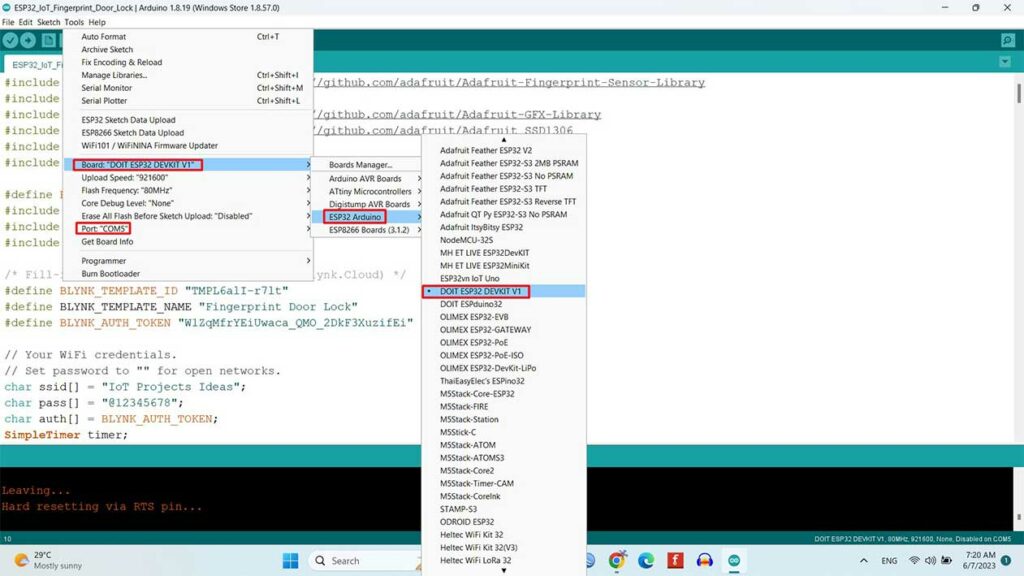
Demo and Testing: IoT Fingerprint Door Lock
After a successful upload, open the serial monitor at a baud rate of 57600. This will allow you to monitor the system’s output and debug any issues. Now, it’s time to test the system.
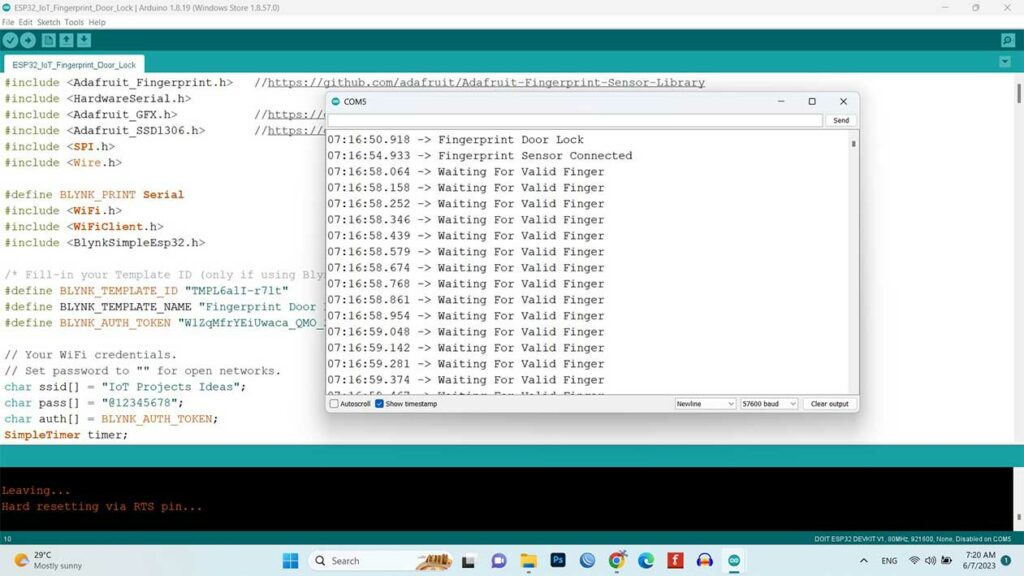
If you don’t know how to Enroll the fingerprint then go through this tutorial about the R307 Fingerprint sensor. Now Try placing your registered fingerprint on the sensor and observe the results. If the fingerprint is authorized, you’ll see the successful fingerprint verification and the relay turns ON to unlock the solenoid door lock. Indicating a successful unlock on the OLED display.
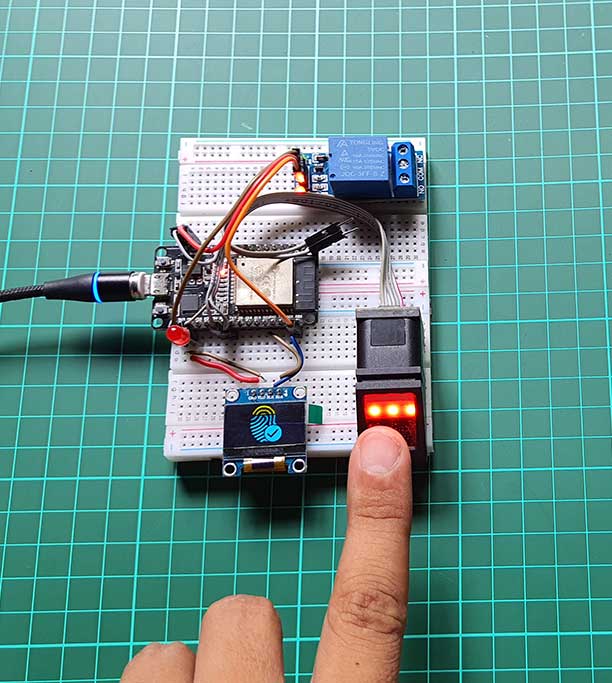
If your fingerprint does not match then the system will notify you through LED or Buzzer as well as From OLED Display.
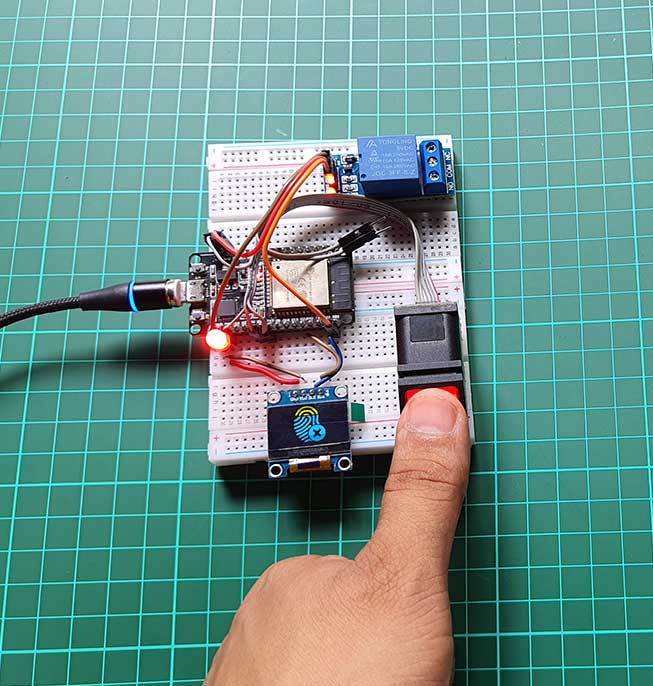
You can also monitor your door lock remotely from anywhere in the world using Blynk IoT mobile App as well as the blynk web dashboard.
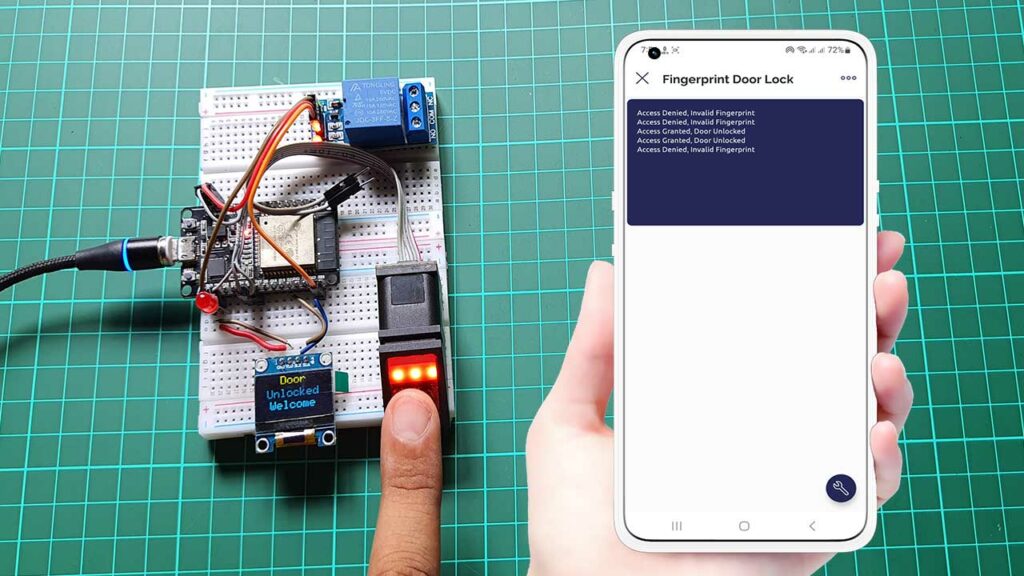
You can always customize the project according to your needs and requirements.
Conclusion
Congratulations! You have successfully built your own ESP32-based biometric door lock system using the R307 fingerprint sensor and Blynk IoT platform. This project offers an enhanced level of security and convenience for accessing your door. Feel free to customize and expand upon this system to suit your specific requirements.

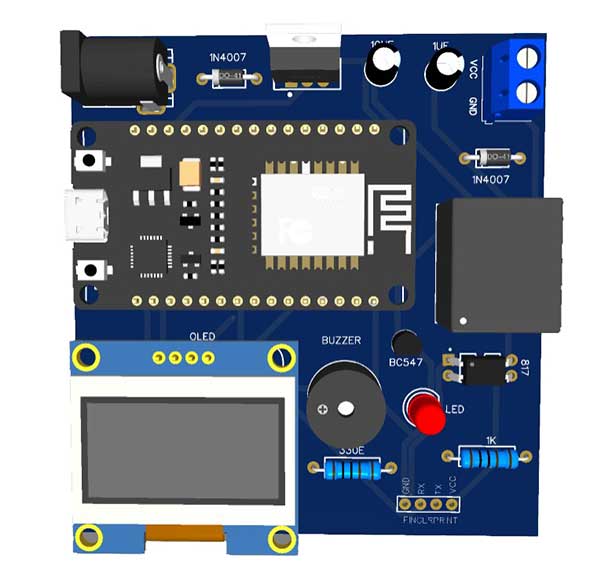
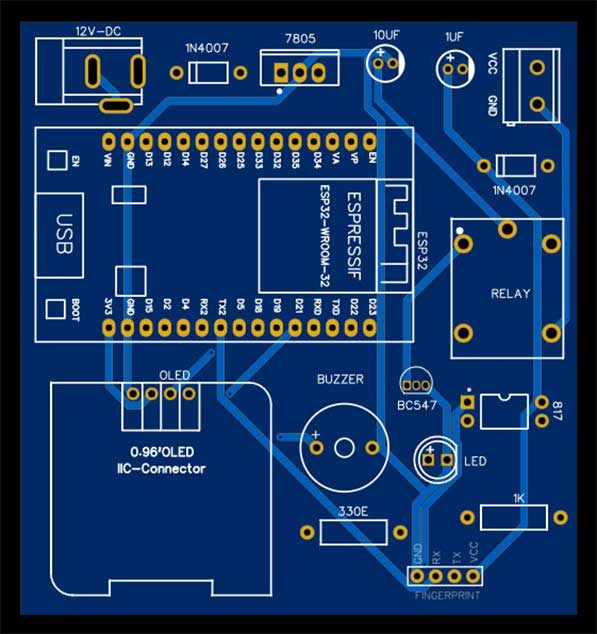
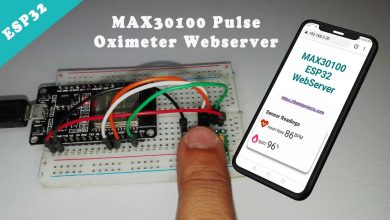
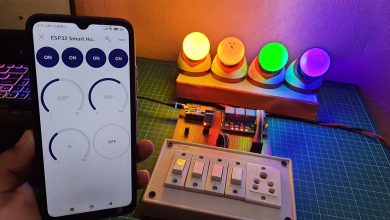
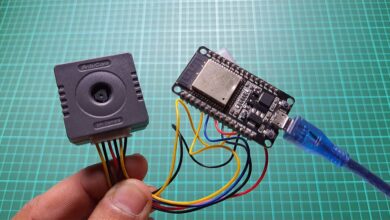
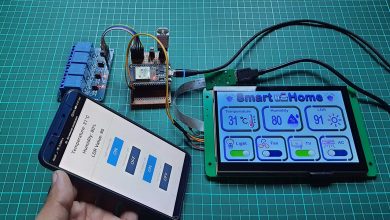
Hi
can you please provide a schematic of PCB layout of this project.
thanks